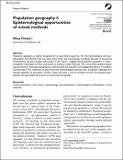Files in this item
Population geography I : epistemological opportunities of mixed methods
Item metadata
| dc.contributor.author | Finney, Nissa | |
| dc.date.accessioned | 2021-01-06T15:30:03Z | |
| dc.date.available | 2021-01-06T15:30:03Z | |
| dc.date.issued | 2020-09-14 | |
| dc.identifier | 270345387 | |
| dc.identifier | 36b6624a-b95c-46e8-8795-1fd7dae438dd | |
| dc.identifier | 85090929209 | |
| dc.identifier | 000570175600001 | |
| dc.identifier.citation | Finney , N 2020 , ' Population geography I : epistemological opportunities of mixed methods ' , Progress in Human Geography , vol. OnlineFirst . https://doi.org/10.1177/0309132520955236 | en |
| dc.identifier.issn | 0309-1325 | |
| dc.identifier.other | ORCID: /0000-0001-6602-9920/work/80995420 | |
| dc.identifier.uri | https://hdl.handle.net/10023/21227 | |
| dc.description.abstract | Population geography is rightly recognised for its quantitative expertise. Yet, the methodological and epistemological diversification that has taken place within the sub-discipline alongside decades of theoretical developments has gone largely undiscussed. In this report, I suggest that population geography is methodologically multilingual and thus well placed to embrace mixed methods. This would bring epistemological opportunities for population geographers, advancing the sub-discipline and engagement beyond in academia and elsewhere. The confluence of theoretical and methodological developments, and global challenges that demand attention of population scholars, means the time is ripe to broaden the lens of population geographies through deliberate pursuit of mixed methods agendas. | |
| dc.format.extent | 9 | |
| dc.format.extent | 209679 | |
| dc.language.iso | eng | |
| dc.relation.ispartof | Progress in Human Geography | en |
| dc.subject | Critical quantitative social science | en |
| dc.subject | Epistemology | en |
| dc.subject | Interdisciplinarity | en |
| dc.subject | Methodological multilingualism | en |
| dc.subject | Mixed methods | en |
| dc.subject | G Geography. Anthropology. Recreation | en |
| dc.subject | Geography, Planning and Development | en |
| dc.subject | T-NDAS | en |
| dc.subject.lcc | G | en |
| dc.title | Population geography I : epistemological opportunities of mixed methods | en |
| dc.type | Journal article | en |
| dc.contributor.institution | University of St Andrews. School of Geography & Sustainable Development | en |
| dc.contributor.institution | University of St Andrews. Centre for Minorities Research (CMR) | en |
| dc.identifier.doi | 10.1177/0309132520955236 | |
| dc.description.status | Peer reviewed | en |
This item appears in the following Collection(s)
Items in the St Andrews Research Repository are protected by copyright, with all rights reserved, unless otherwise indicated.

